Hampton Court Palace Flower Show Bangladeshi Allotment Vegetables
click here to return to Bangladeshi Allotment
click here to return to Vegetable Finder

Bottle gourd (Lageneria vulgaris)
or Dudhi or
Lauo or Khodu
Very vigourous. Grows to 6 metres height in UK. Harvest fruits for eating 4 weeks after setting. Hollowed
dried fruits made into water containers and instruments (calabash). Shoots are cooked and eaten like spinach.
Heavy fruits
need support (eg gourd structure or wires)
Sow in April inside (eg windowsill at 18 degree C) for growing-on indoors
in good light in 20cm pots to 120cm high for planting outside late May/ early June in prepared beds of rich, well drained,airy
soil with lots of manure (on mounds of manure). Avoid root disturbance.
Likes as much sun as possible
Needs to
be moist but not wet and keep dry in cold weather
Keep mature plants well watered and spray in hot weather
to set fruits. Once flowers start, feed with high potash fetilizer every week.

Serpent gourd (Lageneria vulgaris)
Grown
in Sicily as well as Asia/Africa. Probably imported from North Africa.
Grows to 4 metres high. Flowers more prolifically
than Bottle Gourd. Fruits up to 2 metres long (either hanging vertically or snaking on roof of gourd structure).
Cultivation
as Bottle Gourd
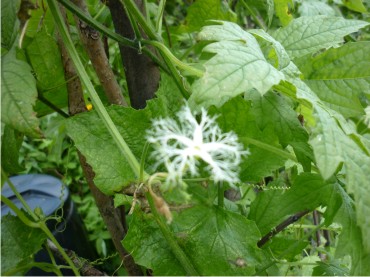
Snake gourd (Trichosanthes
cucumerina) or chichinga
Grows to 3 metres height in UK. In Asia grown on 2metre high frames and trained along cross-wires with fruits hanging down
Cultivation as for Bottle Gourd but seed takes long time to germinate and seedlings and young plants must not be overwatered
and kept on the dry side

Ridge gourd ( Luffa
acutangula ) or Luffa or Jhinga
The bathroom luffa is the dried fruit of the smooth (non-ridged) variety Luffa aegyptiaca (Luffa cylindrica) which
has yellow flowers,
Habit and cultivation as for snake gourd
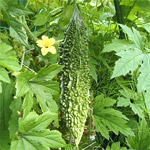
Bitter gourd (Momordica charantia) or karela or
balsam pear
Habit and cultivation as snake gourd except it likes moisture and needs a lot
of water
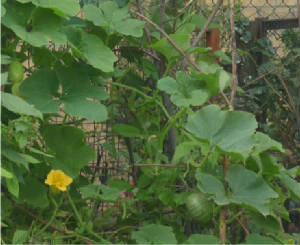
Asian pumpkin or Fig leaf pumpkin (Cucurbita
ficifolia)
Extremely vigourous. Grows to 8 metres height and more (up trees,across fences, and sprawls)
Continues
growing and fruiting late in cold weather (eg November in UK)
Cultivation as for Bottle Gourd except that it grows anywhere
and will find the sun
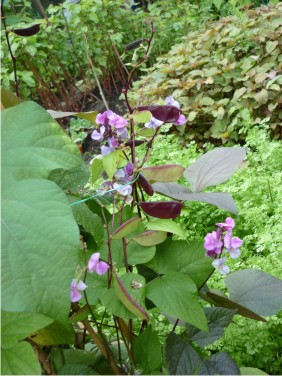
Lablab beans (Lablab purpureus) or hyacinth beans
or Seem
Grows to 3metres height (but beautiful dwarf varieties are available).
Sow in March/ April on
windowsill or greenhouse in pots/trays (one seed per pot to avoid root disturbance). Keep seedlings moist but not wet.
Do not overwater in cold conditions.
Transplant to prepared bed with one plant per cane or thick stick. Plant dwarf
varieties eight to a 40cm pot.
Needs plenty of light and sun and rich loamy water retentive soil containing organic matter
(eg in double dug trench). Feed weekly with high potash fertilizer after flowering starts. Spray in warm weather to set fruits.
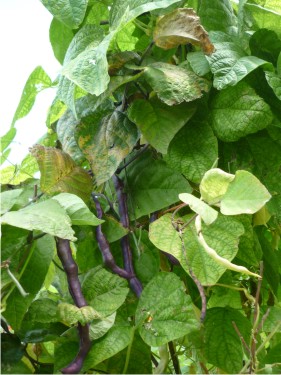
yardlong beans (Vigna unguiculata subsp. sesquipedalis) normally green but photo shows purple and white varieties.
Cultivation as Lablab Beans but propagation and initial cultivation in greenhouse/coservatory with heat or big sunny
window. Plant out in June in hot, sheltered position

Climbing Malabar spinach (Basella alba)
Grows up to 3metres height eg on cane pyramid or trellis for harvesting leaves and stems
Soak
the seeds in water the night before planting. In spring, sow seeds 6mm deep indoors two per pot and water well.
Keep the soil moist until the seeds germinate.When seeds germinate pour liquid fertilizer over the seedlings, making sure
to wet all of the leaves. Do not allow to dry out but water sparingly. Plant out four to a 40cm pot and place in garden or
greenhouse. Malabar spinach doesn't have many pests or diseases. If the plant gets too big, simply cut it back. Can be
overwintered indoors or in greenhouse.
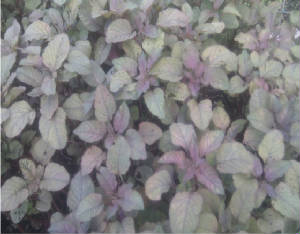
Amaranth (amaranthus cruentis, blitum or dubius) or dougie in Bangladesh or calaloo in West Indies (often confused with similar American grain varieties,
some of which are also ornamentals)
Grows to 1metre height either in dense beds or four to a 300mm pot. Requires
sushine and warmth.
Leaves and tender stems are cut once plant is 30cm high and reshoot. Thick stems need peeling.
Sow indoors in April in seed trays on light window sill. Fine seed germinates densely in a few days. Prick out seddlings
three to a 30cm pot of rich, well drained soil (50% grit and crocks in bottom). Water well and shade after transplanting
. Then place in sun and keep on dry side to encourage tap-root growth. Feed weekly with fertilizer.
Alternatively, sow
fine seed direct into prepared bed of fine rich loam in June and water well.
Once tap root has grown it thrives
in drought when other crops fail
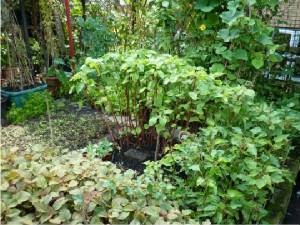
Amaranth (Amaranthus
Gangeticus) or Denga
As dougie above but grown for red stems giving beetroot like colour
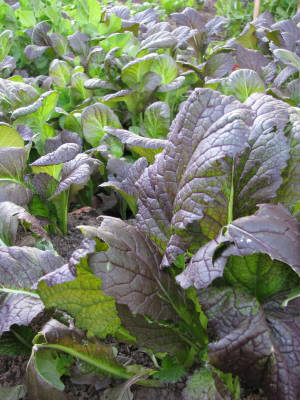
Indian brown mustard (brassica
juncea) or mustard greens
Very hardy and easy to grow, but bolts in hot weather
Sow direct in March but not
too thickly. Harvest leaves May. Suggest don't sow in summer but resow in September

Coriander (Coriandrum sativum)
Seed is purchased from Asian grocers in bulk for sowing direct in late April (as a lawn). Dark seed is
best. Seed should be sprouted before sowing. Wrap a the contents of packet of seed in a wet cloth and place in a polthene
bag in a dark war place for about a week. Sow when seed has sprouted into prepared beds of fine rich well-drained loam. Either
flick sprouted seed onto soil to seperate and acheive spacing (or mix seed with soil before sowing). Then cover with 1cm fine
soil. Coriander can be sown in deep trays or pots instead if desired. Needs sun for 30% of day. Coriander can be harvested
anytime but is most pungent when in flower. Flowers attract bees and other insects and are good for environment